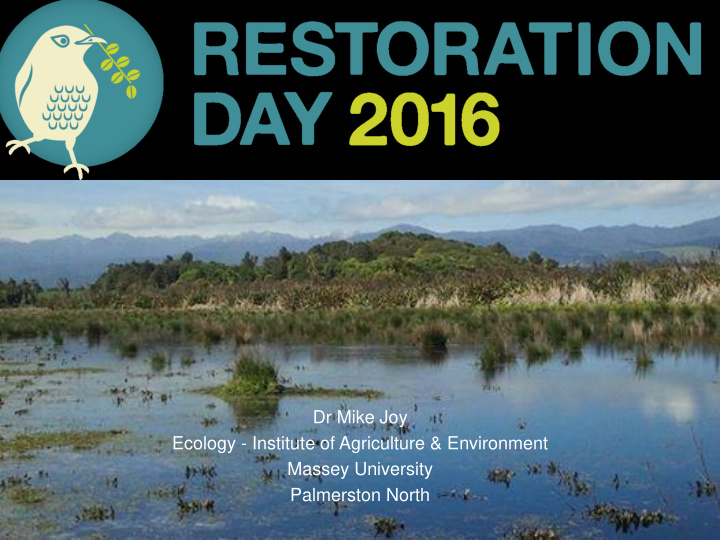



Dr Mike Joy Ecology - Institute of Agriculture & Environment Massey University Palmerston North
1. Some motivation - why we should care (the sad reality - freshwater in NZ) 2. Why what you are doing is so important 3. What healthy freshwater ecosystems need In remembrance of John Sawyer
34 Biodiversity All sites - 74% of freshwater fish threatened 32 - + crayfish and kakahi too - gone by 2050 IBI score 30 - no protection under law for freshwater fish 28 Highest proportion of threatened plants and animals globally including: 26 - 40% of native plants 1970s 1980s 1990s 2000s - 40% of birds - 85% of lizards No. of NZ Species Threatened and At Risk 4000 3500 Taxa Threatened and At Risk 3000 2500 2000 1500 1000 500 0 1997 2002 2005 2008/11 Year
What a failed environment looks like: Graphic from Susan Walker Landcare NZ
What a failed environment looks like
What a failed environment looks like Nitrate ANZECC trigger level
What a failed environment looks like Total P ANZECC trigger level
What a failed environment looks like Healthy Doubtful Moderate pollution Insect community index Severe pollution MCI
What a failed environment looks like Human health - pathogens E. coli NZ now has the highest frequency per-capita globally of coliform enteritis, campylobacteriosis, cryptosporidiosis and salmonellosis 18 – 34K NZers contract waterborne diseases p.a. - benthic cyanobacteria mats (already killing dogs and horses and one day children)
What a failed environment looks like Pathogens Ministry of health risk level
“A fresh start for freshwater” NPS objectives 2014 : (making the problem disappear) A B C After Before
“A fresh start for freshwater” NPS objectives 2014 : (aka making the problem disappear) The government response to the crisis – shifting goalposts “I think our rivers are in pretty good shape” (Minister of Tourism John Key on Q&A a few weeks ago) From 260 cfu/l to 1000 cfu/l After Primary contact (health ministry Secondary contact Before level) (safe in a boat?)
The inconvenient reality: • The biggest impact on our freshwaters is agriculture (its not what we are doing the way we are doing it) • Farming within rules does NOT mean its sustainable or NOT having impacts on waterways • Irrigation & intensification lead to degraded waterways and splintered communities (don’t believe me? go ask Cantabrians) • Dams are NOT good for rivers and do not mitigate climate change
Lonely planet guide
Clearly the government has failed so I guess its up to us now – So all power to community groups
Actually we do care!
Understanding Rivers as a living entity Rivers have evolved over thousands of years both biologically and physically Stream ecosystems driven from bottom up periphyton inverts fish Impacts: Deforestation of catchments flow alteration sedimentation Intensification = nutrient inputs excess plant growth periphyton/algal blooms + Removal of water – intensification of all impacts above and drive intensification so more nutrient and sediment
Restoration and protection of our waterways: 1. At the higher level the best, cheapest (e.g. 37 times cheaper) & easiest way to protect waterways is not to pollute or damage them in the first place, so its vital to be involved in advocacy and protection (be political & vocal) 2. At the ‘coal face’ its riparian planting, removing barriers, reinstating & restoring wetlands, protecting & replanting catchments, monitoring being the eyes of the councils … 3. Start at the top and work down the catchment for water quality and for fish passage start at the bottom and work up
Example of why you have to start at the top 2006 2008 2013
Ecological Impacts of Sediment in Streams • Sediment in waterways impacts life in two different ways via suspended & deposited sediment
The value of restoration Restoration • Make sure you define your goals • Monitor monitor - justify investment time and money, inspire others
The value of restoration Citizen scientists are need now more than ever before • Monitoring protocols (SEV, SHAP, RIT) • http://www.aucklandcouncil.govt.nz/EN/planspoliciesprojects/reports/tec hnicalpublications/Documents/sevuserguide2011001.pdf • http://www.envirolink.govt.nz/PageFiles/31/Stream%20Habitat%20A ssessment%20Protocols.pdf • http://www.niwa.co.nz/sites/niwa.co.nz/files/import/attachments/Rest oration-Indicators-4-WEB.pdf
The value of restoration • Ecosystem functions of rivers, lakes & wetlands incredibly valuable and important so what you are doing is of immense value • Celebrate success! Give awards • The best thing for mental health in an crisis like this is to be doing something to stop the crisis
Recommend
More recommend